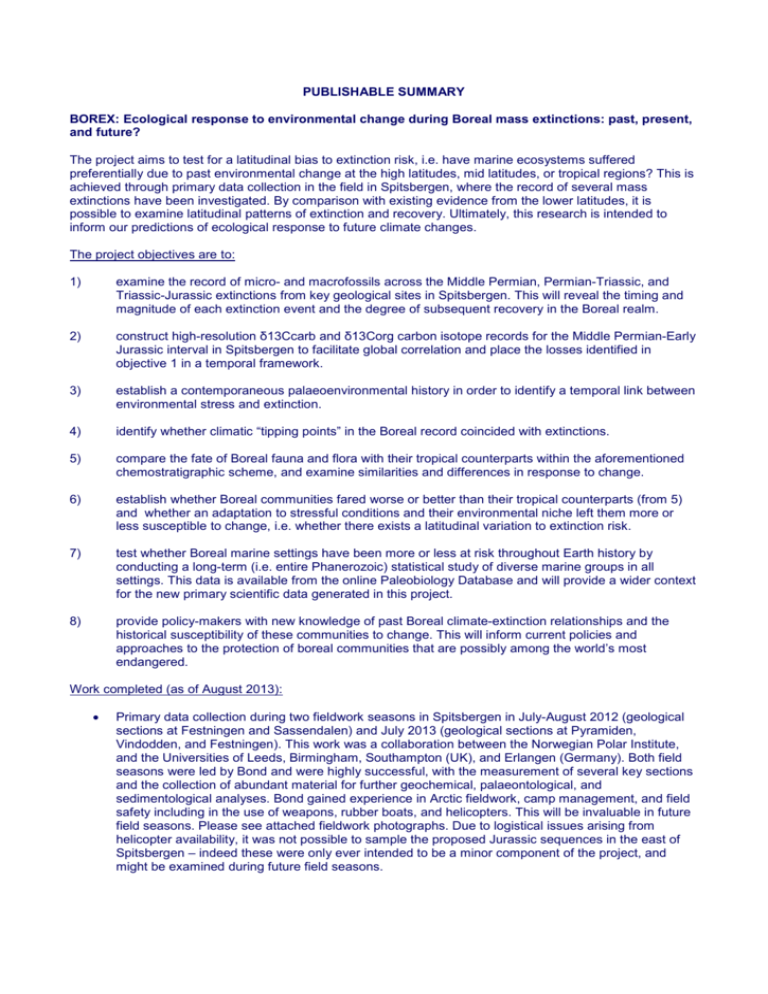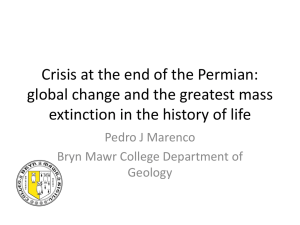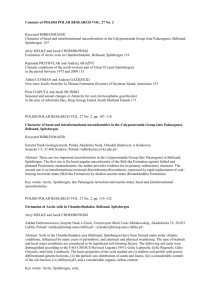final1-publishable-summary-borex
advertisement

PUBLISHABLE SUMMARY BOREX: Ecological response to environmental change during Boreal mass extinctions: past, present, and future? The project aims to test for a latitudinal bias to extinction risk, i.e. have marine ecosystems suffered preferentially due to past environmental change at the high latitudes, mid latitudes, or tropical regions? This is achieved through primary data collection in the field in Spitsbergen, where the record of several mass extinctions have been investigated. By comparison with existing evidence from the lower latitudes, it is possible to examine latitudinal patterns of extinction and recovery. Ultimately, this research is intended to inform our predictions of ecological response to future climate changes. The project objectives are to: 1) examine the record of micro- and macrofossils across the Middle Permian, Permian-Triassic, and Triassic-Jurassic extinctions from key geological sites in Spitsbergen. This will reveal the timing and magnitude of each extinction event and the degree of subsequent recovery in the Boreal realm. 2) construct high-resolution δ13Ccarb and δ13Corg carbon isotope records for the Middle Permian-Early Jurassic interval in Spitsbergen to facilitate global correlation and place the losses identified in objective 1 in a temporal framework. 3) establish a contemporaneous palaeoenvironmental history in order to identify a temporal link between environmental stress and extinction. 4) identify whether climatic “tipping points” in the Boreal record coincided with extinctions. 5) compare the fate of Boreal fauna and flora with their tropical counterparts within the aforementioned chemostratigraphic scheme, and examine similarities and differences in response to change. 6) establish whether Boreal communities fared worse or better than their tropical counterparts (from 5) and whether an adaptation to stressful conditions and their environmental niche left them more or less susceptible to change, i.e. whether there exists a latitudinal variation to extinction risk. 7) test whether Boreal marine settings have been more or less at risk throughout Earth history by conducting a long-term (i.e. entire Phanerozoic) statistical study of diverse marine groups in all settings. This data is available from the online Paleobiology Database and will provide a wider context for the new primary scientific data generated in this project. 8) provide policy-makers with new knowledge of past Boreal climate-extinction relationships and the historical susceptibility of these communities to change. This will inform current policies and approaches to the protection of boreal communities that are possibly among the world’s most endangered. Work completed (as of August 2013): Primary data collection during two fieldwork seasons in Spitsbergen in July-August 2012 (geological sections at Festningen and Sassendalen) and July 2013 (geological sections at Pyramiden, Vindodden, and Festningen). This work was a collaboration between the Norwegian Polar Institute, and the Universities of Leeds, Birmingham, Southampton (UK), and Erlangen (Germany). Both field seasons were led by Bond and were highly successful, with the measurement of several key sections and the collection of abundant material for further geochemical, palaeontological, and sedimentological analyses. Bond gained experience in Arctic fieldwork, camp management, and field safety including in the use of weapons, rubber boats, and helicopters. This will be invaluable in future field seasons. Please see attached fieldwork photographs. Due to logistical issues arising from helicopter availability, it was not possible to sample the proposed Jurassic sequences in the east of Spitsbergen – indeed these were only ever intended to be a minor component of the project, and might be examined during future field seasons. The analysis of several hundred samples for their geochemistry, including carbon and strontium isotopes, was performed on collected material between Sept. 2012 and July 2013 (work is ongoing). This is in collaboration with U. Leeds, U. Erlangen, and the Geological Survey of Canada. For the first time, detailed carbon- and strontium isotope curves have been generated through the Permian of Spitsbergen. Bond has performed analyses and SEM work on his own samples in Tromsø, Manchester, and Leeds, while other samples were prepared by a collaborating partner in Erlangen. These curves represent the first high resolution temporal framework with which to compare extinction records in the Boreal Realm with lower latitude regions, and is a major breakthrough (articles to be submitted to Science and Nature in autumn 2013). See attached documents. Palaeontological analyses of fossils in the field and laboratory during 2012-2013 has revealed the precise timing and magnitude of extinction during the middle and end Permian of Spitsbergen. Over 70% of brachiopod and bivalve species became extinct at a level in the Middle Permian that can now be correlated with that in e.g. China. This implies that the Middle Permian extinction was at least as severe in the high latitudes as it was in warmer regions. Furthermore, the famous end-Permian extinction appears to have struck first in the high latitudes, suggesting that these regions may be more susceptible to major climate change (articles in preparation for high-impact journals). See attached documents. Facies analysis of sedimentary rocks in the field and in the laboratory (microscope work on several hundred thin section slides made from material collected in 2012) has revealed a complex sequence of environmental and sea-level changes in the Permian of Spitsbergen. This data will be incorporated into figures and diagrams (attached) that will be published in leading scientific journals in 2014. Bond has organised “The Permian Strata of Svalbard” workshop, a major (>30 participants from 8 countries) international workshop held in Tromsø in April 2013. He applied for, and received 140,000 NOK (approx €20,000) funding from the Norwegian national research council to support this workshop. The workshop was a major success, held over three days, it stimulated a great deal of collaborative research. This has led to future collaborations between Bond and scientists in Russia, Germany, UK, and Canada (including imminent fieldwork in Russia and Canada that would not have been possible without this contact). Please see the attached workshop group photograph, taken in the FRAM Centre, Tromsø. Bond was the editor of the Abstracts Volume (attached) and will be a coeditor of a thematic issue of the international journal “Polar Research” that has arisen from this meeting. Bond has presented his Spitsbergen research at three international conferences, that of the NGF (Norwegian Geological Society) in Oslo, January 2013, the “Volcanism, Impacts and Mass Extinctions” conference at the NHM in London in March 2013, and the “Permian Strata of Svalbard” workshop in Tromsø in April 2013. Publications: Bond has authored seven international peer reviewed articles during the period of his Fellowship (two as first author, see list of publications). Several more key articles arising from the Fellowship research are currently in preparation for the leading journals Science and Nature. Results and wider impact The main findings are detailed above, but key amongst these are the production of the first ever high resolution temporal framework for the Permian strata of Spitsbergen, within which to compare ecosystem and environmental changes in high latitudes with those in lower latitude settings. This has revealed that the Middle Permian extinction was at least as severe in the high latitudes (and very abrupt), and that the end-Permian extinction struck first in the high latitudes. These findings have major implications for the scientific community that works on past and present environmental change. The findings may also influence ocean governance policy, because the implication is that high latitude ecosystems are likely to suffer preferential losses due to recent and future climate change (publications to be submitted). It might therefore become policy to invest in added protection of the Boreal regions today. The beneficiaries of this research clearly extend across those working in similar scientific fields, the general public that is interested in extinctions, climate change and environmental protection, to policy makers, and ultimately global populations that rely on healthy, high latitude marine ecosystems.









